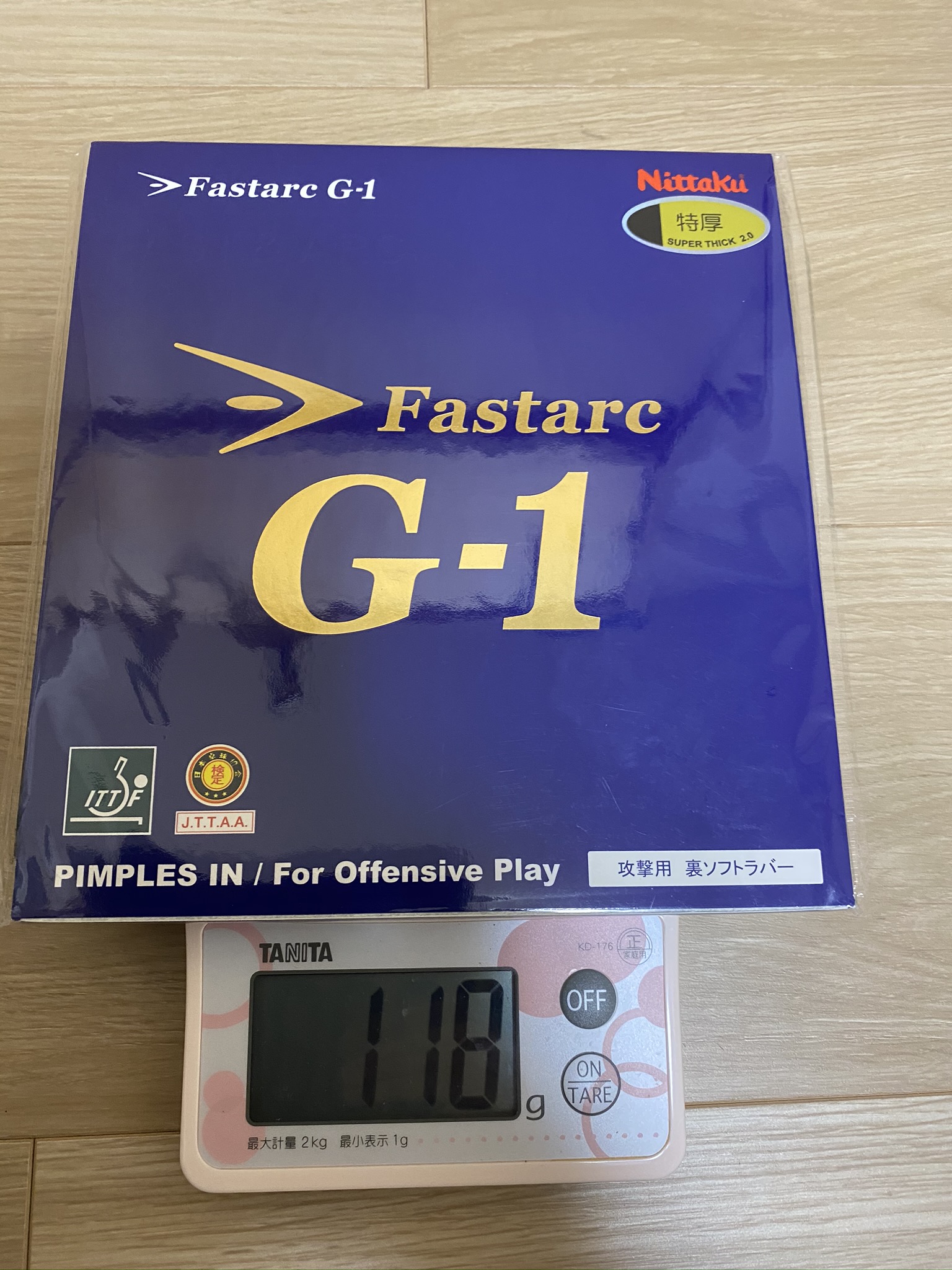
Explanation
The best-selling rubber in Japan. It’s neither Butterfly’s monster rubber, the Tenergy series, nor Dignics, which surpasses monster rubber. The best-selling rubber in Japan, it will be Nittaku’s Fastarc G-1! It can be said that it was too late to review, but I was finally able to try it out, so I will review it again.
Why is Fastarc G-1 the best-selling product in Japan?
There are three main reasons why this rubber is the best-selling rubber in Japan. The three reasons are as follows.
・Introduction of plastic balls
・Price increase of the Tenergy series (open price)
・Use of top players
・Introduction of plastic balls
With the introduction of plastic balls, the balls have become harder. When the ball was changed from 38 mm to 40 mm, it became harder to rotate, but it didn’t rotate anymore. Following the change from cell balls to plastic balls, the evaluation of hard and rotating rubber has risen. Fastarc G-1 is a hard and rotating rubber, so it can be said that it is a rubber that fits plastic balls. It can be said that the introduction of plastic balls has raised the evaluation of Fastarc G-1.
・Price increase of Tenergy series (open price)
Monster rubber and Tenergy series are now open price. This is a real price increase. Before the open price, the table tennis shop was able to benefit from a 20 to 30% discount on the list price, which was around 5,000 yen. However, Mr. Butterfly has become an open price, and now Tenergy has become an expensive rubber that costs more than 7,000 yen. It has become a rubber that selects the user again. It seems that the number of players exploring post-Tenergy has increased due to this influence. Certainly, when it costs 10,000 yen for one piece of rubber, it seems that many table people’s wallets seemed to be tough. The Fastarc G-1 has a list price of 6,000 yen + tax and pricing may have been just right. From this price, you can get a store discount at the table tennis shop, so you can actually buy it for less than 5,000 yen!
・Use of top players
And finally, it’s the usage record of top players. After all, it is Kasumi Ishikawa and Mima Ito of the Japan Women’s National Team. In addition, both boys and Masatoshi Morizono use Fastarc G-1 for Chiquita. It can be said that the fact that both male and female top players have a track record of use in this way has a very large advertising effect. It seems that Kasumi Ishikawa is not currently using it, but Mima Ito is using it on the fore side! (Rumors such as SNS say that Mima Ito is currently using the 50 ° Fastarc G-1, but he is using the Fastarc G-1 anyway). It is true that the fact that Mima Ito is using it has become a huge advertising effect and trust, and many tablemates have come to think that they want to use it or want to use it.
Fastarc series
I would like to touch on the origins of the Fastarc G-1 and other Fastarc series. According to Nittaku, Fastarc’s name is a coined word that combines the English words Fast and Arc! The rubber with the highest rotational performance in the Fastarc series is the Fastarc G-1.
Other Fastarc series have the same sponge hardness and speed type sheet grain shape, Fastarc P-1, and the sponge hardness is soft and the same type sheet grain shape as G-1. Fastarc C-1 is on sale, and Fastarc S-1 is a speed type sheet with a soft sponge hardness. There are not as many types as the Tenergy series, but it can be said that it is easy to pick up as a post-Tenergy because the explanation is easy to imagine on the pamphlet. Also, unlike the Tenergy series, the Fastarc series has different prices depending on the type, G-1 and P-1 are the highest, and C-1 and S-1 with soft sponge hardness are also happy that the price is set cheaply. Hey. If you feel that G-1 is too hard, you may want to change to C-1.
The G of Fastarc G-1 seems to be the G of Grip, and it is said that it is a rubber that “grips with a seat and draws an arc”.
Published performance value

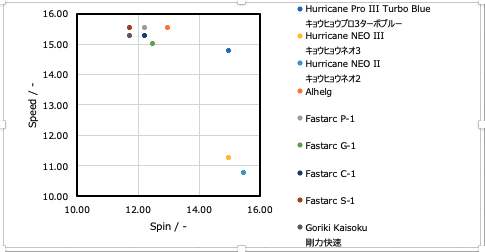
Nittaku also sells the Hurricane series that uses seats made in China, and two of the Hurricane Pro III Turbo series and other Hurricane series that have become a hot topic in recent years. The rotation performance of the is remarkably high. Rubbers such as the Fastarc P-1 and Alhelg, which disappeared from the 2020 pamphlet, are more expensive than the Fastarc G-1 in terms of speed performance. It can be said that the rubber that is most often referred to as the balanced type is the standing position among the Nittaku rubbers of Fastarc G-1. Or is it the rubber with the highest rotational performance among spin tension rubbers?
Fastarc G-1 sticking and weight

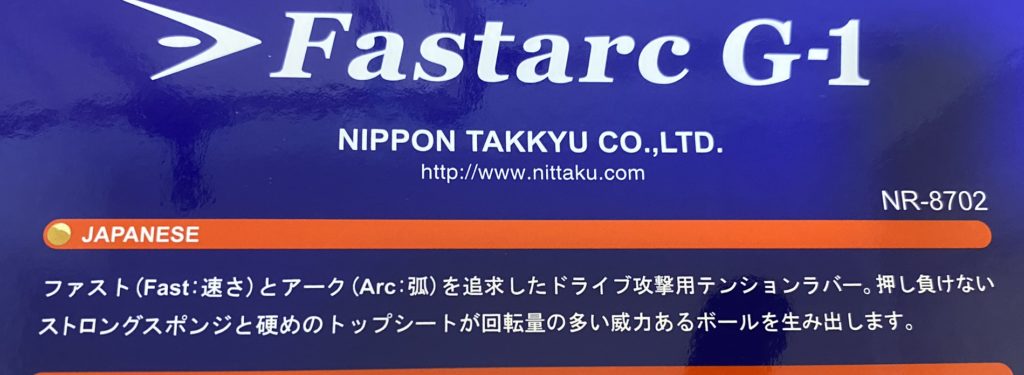
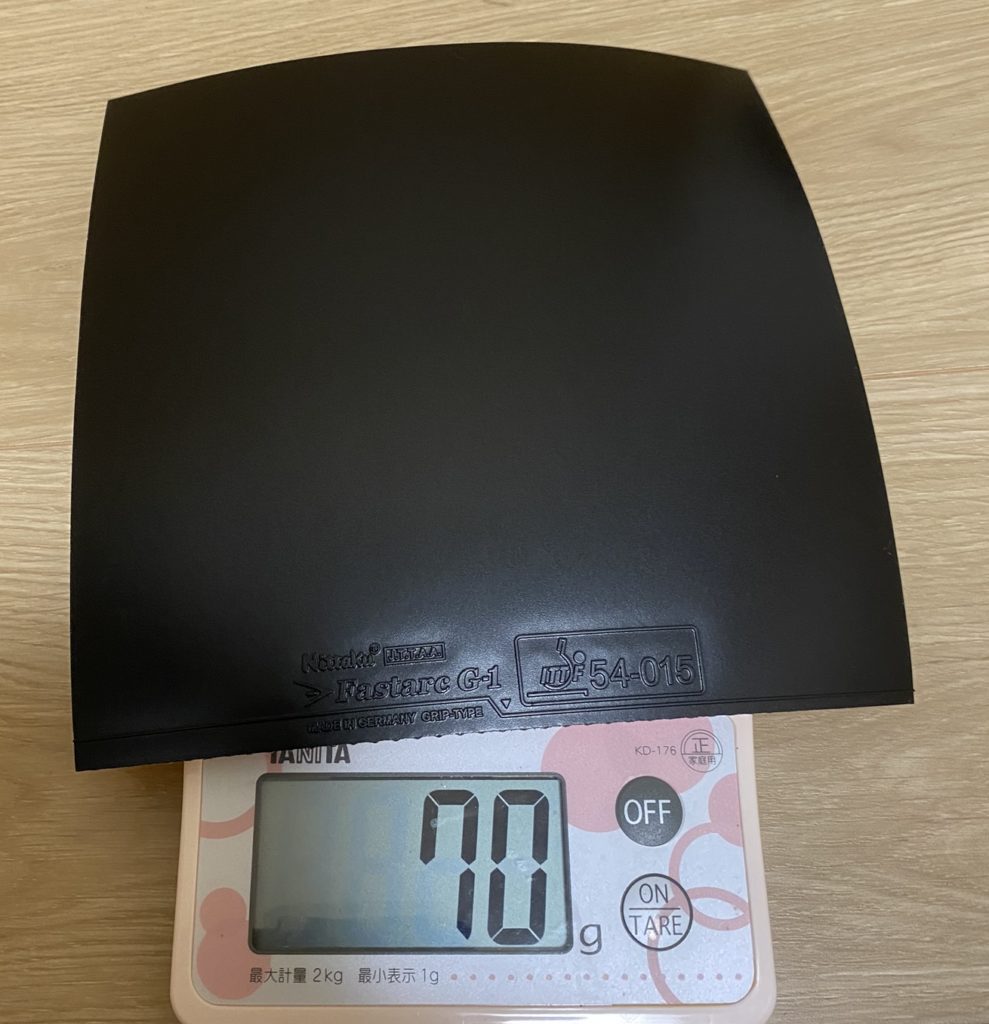

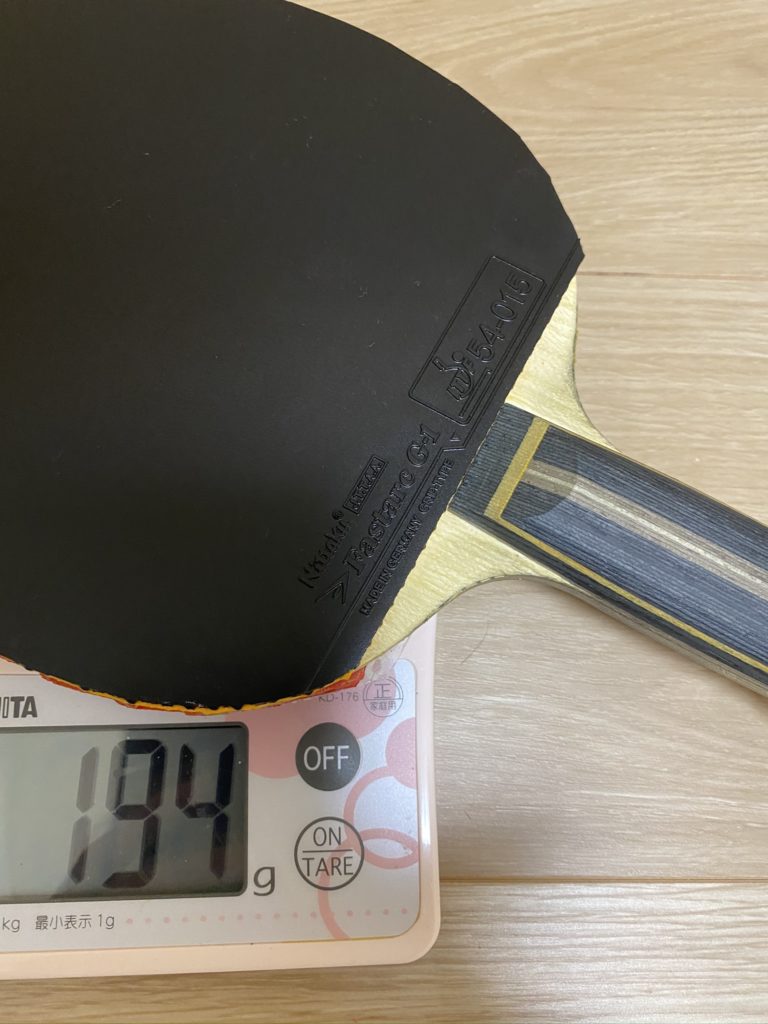
Fastarc G-1 Tension Spin Sheet Strong Sponge ・Speed: 15.00 ・Spin: 12.50 ・Sponge Thickness: 1.7 mm, 1.9 mm, 2.1mm, Max ・Sponge sttifness: 37.5 (German standard: 47.5) ・6,000 yen + tax ・70 g (before cut) → 48 g (after cut)
Three features of Fastarc G-1
If you can control it well, it will take a lot of rotation!
This rubber felt very good. After all, I felt that it would take a lot of rotation. I’m seriously thinking about using it for my job. Sweat. It took a lot of rotation! Serve was also able to make a downward rotation like the ball returns like Dignics 05! This is great! It will be a comparison with Dignics 05, but the ease of handling is overwhelmingly G-1, and the speed performance is better with Dignics 05. Also, while I felt the high performance of Dignics 05 for the ease of aligning the balls, I felt that the G-1 had a wide range of rotation. I felt once again that this difference is a part that must be noted when the opponent uses the G-1 in the game.
Chiquita is easy to do! Easy to control both spin type and speed type chiquita!
After all I felt that Chiquita was extremely easy to put in. You have plenty of time to grip the ball. I felt that the amount of rotation would drop a little, but the Fastarc G-1 was easier to do with Chiquita than the Dignics 05! I understand why Morizono uses it!
You can hit a drive with a wide range of spin!
As I mentioned in the first one, I think it’s a habit ball that seems to be German rubber or G-1. Even if I was driving in the same way, I felt that there was a considerable range of rotation amount depending on when I was able to apply rotation as much as I could and when I just put it in or bounced it. I felt that this has the effect of disturbing the opponent’s block angle by using the Fastarc G-1. Actually, I also felt that the block angle was easy to get out of order when the opponent was driving with G-1 in the game, but I felt that it was easy to hit such a drive!
Each technical review
Forehand
Light hit
I didn’t feel any discomfort. I felt that the hardness was quite similar to that of Dignics 05. I felt that it was a little hard and hard rubber compared to Tenergy.
Drive on long balls and rallies
When using the G-1, I felt that the lower the ball, the less the ball stretched. If it goes down, it will drive like playing, but I felt that it would be a drive that does not stretch and speed does not come out with such a rotation method. If you rotate it with a sheet like using adhesive rubber, or hit it like V> 15 Extra and make it bite into it, and then rotate it from the bite before you play it, you can hit a good drive with rotation. I felt that. Perhaps the G-1 has a Tenergy 05-like feel and a grip like an adhesive rubber, so I felt that it would be easier to drive even with a drive that captures only the seat and takes the plunge to rotate. I’m not used to driving when I bite into it and spin it, but I felt that V> 15 Extra is probably more likely to be a violent drive.
Also, because it is a hard rubber, I felt that the ball was released fairly quickly. In the front team, I think you can feel the speed of the ball because it is quite fast. On the other hand, when driving from the middle team and the apse, if you do not hit it fairly firmly, you may feel lack of power such as insufficient speed and insufficient rotation. On the contrary, if it doesn’t go down to that level, I felt that G-1 was better than Dignics 05.
Drive with open face
This is also easy to hit! It felt very good. It was quite difficult to put the amount of rotation on the speed drive, but it was easy to stabilize, so it felt very good!
Loop (top spin) drive against back spin
This was a pretty good feeling! I felt that you could drive with a very strong rotation. I think it’s a good rubber. In terms of the amount of rotation, I think it is at a level comparable to Tenergy 05 and Dignics 05. Probably, in plastic balls, the maximum value of the amount of rotation may be higher in G-1 than in Tenergy 05 due to the hardness of the sponge.
Speed drive against back spin
I think the amount of rotation will drop, but it was very easy to hit. This was a strange feeling. The image of Tenergy is that the swing speed and angle are more severe. I think it’s because I’m not good at spinning with speed drive.
Curve / shoot drive
This didn’t bend as much as I expected. After all I felt the range of the amount of rotation.
Block
It was easy to do because I could grip the ball. Especially the block for speed drive was pretty easy to do!
Counter drive
I felt that it was a little more susceptible to the influence of the opponent’s drive because it was easy to spin. I felt that it was necessary to get used to this area.
Stop
It grips, so it was very easy to stop. nice one!
Push
It was good because it also grips. However, it seemed to be lighter if I took it easy.
Serve
I’m glad I was able to cut it firmly. It felt pretty good!
Back hand
Light hit
I’m glad I didn’t feel any discomfort here either! Rasanter R48 and Rasanter R53 were also good rubbers, but due to the difference in the grain shape of the sheet, it was easy to feel the ball coming off, and I felt that it was necessary to get used to it. However, I like the G-1 because it has a thick grain and a narrow grain shape between the grains, so you can hit the ball with the image of firmly gripping the ball and then releasing it, which gives you a sense of stability. Is good!
Drive on long balls and rallies
This was also very easy to do! In the case of Dignics 05, the speed and the amount of rotation are very high, but the appearance of the arch line and the trajectory of the ball change considerably depending on whether you hit it like playing or hitting it with rotation. With a backhand that tends to slow down the swing speed, it often fails to rotate the ball, so it’s really difficult to stabilize, isn’t it? Sweat. On the other hand, since there is no such thing in G-1, I felt that the return ball itself was very easy to do. However, I think that the ball quality is likely to be low. However, by using high-performance rubber such as Dignics 05 for the forehand, I felt that the difference in ball quality could be used as a weapon! This was also felt when using V> 15 Extra. I think the combination of Japanese rubber and German rubber is an ant!
Loop (top spin) drive against back spin
Very easy to hit! nice one~! It grips so it was easy to hit the ball as you imagined! By taking the plunge, I was able to put it on the opponent’s court without anxiety!
Speed drive against back spin
It’s also an easy-to-play rubber, so it was easier to do than Tenergy 05! Dignics 05 is also easy to get speed, and recently it has come in quite a bit, but maybe it is easier to handle than Dignics 05, so I feel that G-1 can enter even if the swing speed is slow!
Block
German rubber balls are easy to block, but loop drives such as the Dignics 09C are subject to rotation and have many over-misses. I felt that it was necessary to get used to this area. I don’t feel like the seat is losing, so I think you can get used to it.
Counter drive
I found it easier to do than Tenergy 05. I feel that the seat is strong.
Stop
This was also good! It will stop!
Push
It will expire! Is good! Because it grips firmly, it didn’t float and I liked the shot feeling!
Chiquita
It’s easy to do! It was great!
Comparison with other rubbers (individual impressions)
Spin amount
Dignics 05 > Fastarc G-1 ≧ Tenergy 05
Ease of spin
Tenergy 05 > Fastarc G-1 > V>15 Extra
Speed
Dignics 05 > V>15 Extra > Fastarc G-1 > Tenergy 05